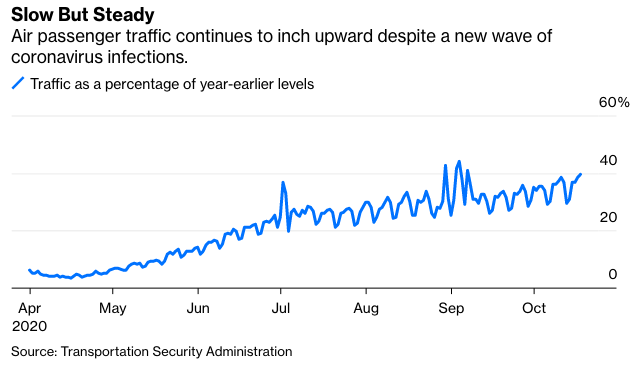The latest spike in coronavirus cases and hospitalizations has people worried about more than just the public health impacts. There's also the threat that renewed constraints on activity could drag the economy backward as we head into colder winter months.
Air travel is one kind of in-person economic activity that's been hard-hit by the pandemic. It suffered another setback during the summer virus wave, so it's noteworthy that in the latest surge, the industry hasn't yet seen a negative impact. In fact, this past Sunday it recorded the first day with 1 million passengers since the onset of the pandemic.
While demand for flights is likely to remain significantly impaired at least until the public health situation improves, the uptick shows that the airline industry is convincing growing numbers of would-be passengers that traveling on a plane is safe. And that makes it less likely that subsequent virus waves will reduce air travel and related economic activity beyond their current depressed levels.
Air travel virtually disappeared in March as the pandemic took hold in the U.S. and shelter-in-place orders went into effect. Then the industry experienced the equivalent of a dead-cat bounce from mid-April through the early part of July. Passenger checkpoint data published by the Transportation Security Administration bottomed at 4% of normal levels, and by mid-July it had recovered to 27%.
That's when the flare-up of the virus in Southern states dealt the industry a setback. As virus case counts surged in places like Arizona, Texas, Florida and Georgia, and states like New York began requiring passengers coming in from hot spots to quarantine themselves, the TSA data was backsliding. By the end of July, traffic had fallen to more like 25% of normal levels. While only a minor setback, it derailed a theory put forth by optimists in early June that air travel could normalize by August based on the pace of the recovery seen in April and May. By the end of July, airline stocks had fallen to two-month lows even as the S&P 500 Index had recovered to post-pandemic highs.
Now, after months of messaging from airlines and the Centers for Disease Control and Prevention about mask requirements and frequent air circulation and filtration during flights, instead of seeing air travel backsliding with the latest virus wave, it continues to normalize somewhat.
In late August before Labor Day, passenger traffic was around 29% of normal levels, and through Sunday it rose to north of 35%. That still isn't enough to stop airlines from burning cash, particularly given heavily discounted fares and weak business travel, but it shows that virus flare-ups may no longer be enough to lead to further backsliding in passenger traffic.

To the extent people are convinced that sharing airspace with fellow passengers is safe so long as everyone is masked, the main headwind for further normalization may be what happens once you've left the plane. Disneyland in California remains closed, as do the theaters on Manhattan's Broadway. Dining inside restaurants is still a high-risk activity nationwide — to the extent it's even allowed — and there still isn't much in the way of sports games, business conferences or concerts to attend.
Trips to the beaches of Hawaii might be lovely, particularly if taking a rapid test pre-flight eliminates the need to quarantine upon arrival, but many of the reasons to travel have been eliminated even if the plane trip itself is seen as lower risk than it was a few months ago.








